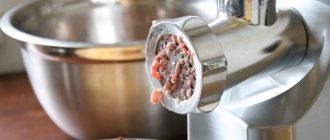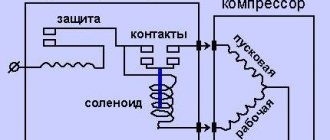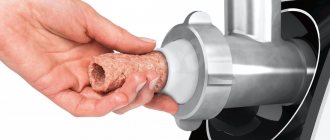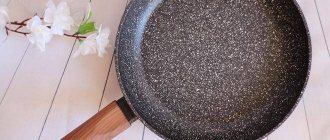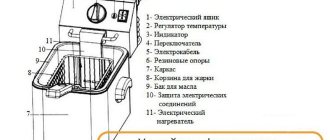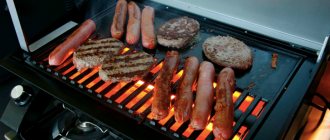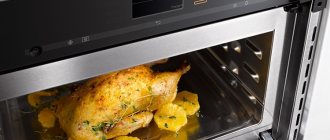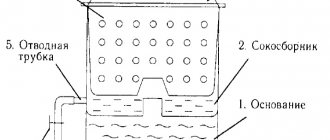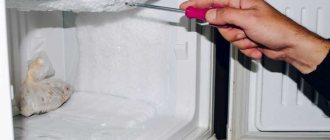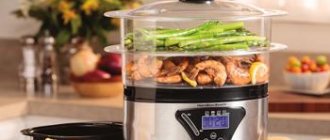What does an electric or manual meat grinder consist of - device and parts
In fact, the parts and operating principle of an electric and mechanical meat grinder are almost identical. Therefore, knowing the structure of one, you can easily understand other modifications.
The only difference is that the electrical appliance has a motor. The action of a manual meat grinder starts the rotation of the handle.
Another difference I can mention is the fastening of the mechanical device to the surface - an electric meat grinder does not require such fixation.
I think that when you figure out how to use a meat grinder, you will want to make minced meat - so read on to learn how to choose the right meat for it.
Electric motor
The electric motor allows the working part (screw) to function - on average, the performance indicator is 30 kg per hour, but it may vary depending on the model and functionality of the device.
In conjunction with the engine in any meat grinder there is a gearbox. Its task is to reduce speed and increase torque. The gearbox consists of gears of different sizes, made of plastic or metal - most often manufacturers use plastic. Devices with metal gears are less common (since they are more expensive), but are considered somewhat more reliable.
In addition to the gearbox and motor, manufacturers also install control boards and fuses.
Screw
From German, the word “auger” is translated as “snail” - obviously, the name is due to the appearance of the part. The main task of the element is to move the meat inside the meat grinder towards the exit. It is made from durable metal alloys - when the meat hits the ribs of the auger, it is trimmed, ground, turning into minced meat.
You can connect the auger to the housing using:
- Metal hexagon. This method is found on low-power devices. To use a meat grinder with such a mount without problems, be sure to make sure that there is protection against jamming.
- Plastic spline connection. It is installed on medium-power meat grinders. This method has a significant disadvantage - if the edges break off, the engine will run idle.
- Metal spline connection. This mount is installed on powerful meat grinders. The more faces such a slot has, the better it can withstand loads.
Cutting part
The main part of this part is the knife, which cuts the products passing through the working container. Modern models are equipped with forged screw-shaped knives made of stainless steel, so they are not afraid of contact with liquid.
During rotation, these knives are partially sharpened on the grid, which is also made of steel.
But for high-quality cutting and long-term operation, it is recommended to periodically sharpen the knives yourself with sandpaper. The sharper the edge, the better the meat is processed.
The shape of the knives is also important, as it directly affects the shape and quality of chopping products. For example, curved ones are considered the most optimal because they easily crush veins and fibers and prevent the auger from clogging.
Lattices
Grates are perforated discs with holes, the size and shape of which determines how the mince will be. There are options for hole diameters:
- small - from 3 to 3.5 mm;
- medium - from 4 to 5 mm;
- large - from 8 to 9 mm.
You can change the grates to get the consistency and grind you want.
For example, small grids are most often used for grinding nuts, and large ones are used for preparing juicy minced meat for pasties.
The discs have a different number of holes through which the minced meat comes out. The maximum quantity can reach 48 pieces - meat for meatballs, chopping cheese and nuts is best achieved with such a detail. A disk with 18 holes will produce coarse minced meat; it is usually convenient to make homemade sausage from it. Modern models are equipped with different disks.
You might be interested in recipes for delicious homemade sausage.
Clamp
The task of the part is to fix the grid and rotating knives. In working condition, the clamp nut tightens itself, since all parts rotate quickly.
Modern meat grinders come with a special device that will help you unscrew the nut or tighten it. In earlier generation models, the nut can be unscrewed by hand counterclockwise (for example, by wrapping it in a cloth).
Tray
Products for grinding are loaded into it - sometimes manufacturers call it a tray in the documentation. There is a hole in the tray leading into the neck of the meat grinder, through which the products are pushed down by a pusher.
The element is made of plastic and metal - in the first case, the tray is less wear-resistant and loses color over time. Trays come in different shapes and sizes, it all depends on the configuration and configuration of the meat grinder.
The main components of an electric meat grinder
Let's look at the main components and components of electrical models and explain the tasks they perform in the device.
Housing with motor and gearbox
The main components of any electric model. The engine is necessary to transmit movement to the working parts of the meat grinder (auger). The gearbox reduces engine speed and increases torque (the force with which the shaft rotates). Its mechanism consists of several gears of different diameters (plastic or metal). A gearbox with plastic gears is the most common option. It costs less and weighs less, however, if the motor jams (sudden stop due to overload), the gear teeth may break. The design with metal gears is considered more reliable, is less common, weighs more and costs slightly more.
In addition to the engine and gearbox, the housing can hide: an on, off and reverse button with terminals, a control board, and fuses. The presence of these components depends on the specific manufacturer and design features of the model.
This is a working shaft twisted in a spiral. Its main task is to move products to the exit. As he advances, he picks up the pieces, crushes them, dividing them into portions with ribs, and pushes them towards the knife. A long shaft with a large number of turns will better prepare food for slicing than a short one. Good meat grinders use only a metal auger made of stainless materials.
Reception chamber
A metal nozzle in which food is processed. On the inside it has edges that facilitate the passage of meat and help the auger push it towards the knives. A knife, grid and auger are inserted into the receiving chamber, and the products are loaded through the neck at the top. Most often this attachment is one-piece, however, there are a number of models in which the camera is disassembled. For example, in the Philips HR2743/00 meat grinder it can be opened into two parts to be rinsed under running water. And in the Philips HR2723/20 model, a special sleeve is inserted inside, on which all the remains are collected. The receiving chamber itself remains almost clean.
Tray
Fits on top of the neck, making it easier and faster to load products. Before processing, it is convenient to place the cut pieces in a tray, and then guide them into the neck with a pusher. The most reliable and convenient is a wide cone-shaped metal tray that is resistant to mechanical damage.
Necessary for slicing and chopping products before passing them through the grill. Knives from different manufacturers may differ in both shape and material composition. The best option is a self-sharpening stainless steel blade that does not require special care.
Lattices
Depending on the size of the holes in the disk, the gratings are divided into 3 categories:
- Small 0.3-0.35 cm.
- Average 0.4-0.5 cm.
- Large 0.6-0.8 cm.
There is a separate grill for beef stroganoff, which has long (up to 3 cm) elongated slots.
Discs with holes of different diameters allow you to obtain minced meat of varying consistency. In addition, they can be selected for certain types of products. For example, for processing tomatoes you can take a larger grid, for smaller nuts.
Additional attachments
These include all kinds of devices for processing fruits and vegetables, for forming cutlets and sausages, as well as for making shortcrust pastry.
Union nut
Holds the auger, knife and grid in one position, fixes the structure during assembly. The minced meat partially comes into contact with the union nut when passing through the grid, therefore, like all main working elements, it must be made of stainless steel. Otherwise, the products may oxidize. The nut has ribs on the outside that help unscrew it after finishing the work.
Additional accessories and functions
In modern realities, a meat grinder is quite capable of replacing a food processor or blender in the kitchen. With various attachments included, you can:
- Make juice with pulp from fruits and berries.
- Thinly slice cheese and potatoes and other hard vegetables. Cutting vegetables is possible in various ways, depending on the shape of the vegetable cutter
- Use special attachments for molding cookies.
- Use the tubes for cooking sausages and sausages.
- Grind coffee and poppy seeds.
- Make noodles.
Read expert advice on how to choose a meat grinder and what to look for when purchasing.
Meat grinder. Types and device. Operation and application. How to choose
A meat grinder is the best way to grind meat and other foods.
In other words, cut them into tiny pieces. Probably in every house there are metal devices inherited from our grandmothers, with the help of which they “twisted” minced meat, making remarkable physical efforts for this. With the advent of new technologies, this difficult everyday task has turned into an exciting procedure for chopping a variety of products to realize the most interesting recipes. This does not require male strength and saves time. Despite the fact that there are many models of household meat grinders offered by manufacturers, there are only two main types of such devices for grinding products: mechanical and electric.
Mechanical meat grinder
This type is the most basic design of a device for producing minced meat, invented back in the early nineteenth century. It is distinguished by its simplicity and accessibility, and functions only when controlled manually using a special handle.
Distinctive features:
- Mechanical devices are smaller in size compared to electric ones and can grind small amounts of food at a time.
- Simple, standard, easy-to-use design with parts made from epoxy-coated cast iron, tin or stainless steel.
- This is a good option for people who are on a budget, have a small family, and only plan to grind a small amount of meat.
Electric meat grinder
An electric meat grinder has a great advantage in terms of labor utilization. It does not require any human assistance and can simultaneously process a large number of products.
Distinctive features:
- Tough parts of raw meat that a manual machine cannot handle can be easily minced in such a machine.
- Not only does it have a high processing speed, but it also chops a large amount of meat in a short period of time. Consumers who prefer precision and speed in their kitchen are in favor of such a device.
- Electric shredders come with a variety of settings to choose from. You can choose very finely or coarsely chopped meat depending on your preference.
- The stainless steel grids, together with the four-blade blade, make this electric machine particularly efficient.
General operating principle
The meat grinder has a funnel at the top of the feed hopper through which you add the cubed meat or whatever you want to grind into the meat receiver. From the funnel, the food is transferred to a screw conveyor. This is achieved using a manually operated torque mechanism or an electric motor. The auger, constantly rotating, steadily pushes the meat down the shaft towards the knife. In this case, large pieces are cut into smaller pieces using ribs on the auger.
The knife and grid are what do the final chopping. The knife is a small cross-shaped piece of metal with sharp blades on each blade that rotates against a grid, also called a die. This is a round metal plate with holes cut in it. As the auger continuously pushes the meat towards this grid, the knife blades slide along its flat surface, grinding the meat into mince. Its texture depends on the size of the holes in the grate. The smaller they are, the finer the minced meat will be.
The disk cover, screwed to the body, reliably presses all the parts together and maintains the integrity of the structure.
Differences
In addition to the fundamental difference in the control method: using a handle that drives all the components and parts of the device, or an electric motor, the main types of devices for grinding products have some other design features.
Mechanical
Must be attached to some stationary flat surface, such as the edge of a countertop. This is done using feet with rubber pads at the bottom of the case and a screw clamp. With this clamp, the legs are tightly screwed to the edge of the tabletop, which ensures reliable fixation of the device during operation.
Electrical
- They have a fairly massive body, inside of which there is an electric motor, and rubberized legs on the bottom. This ensures static immobility of the device.
- There is an on/off button on the body.
- At the top of the meat receiver there is a tray on which you can store pieces of prepared food before pushing them using a pusher into the loading hopper. The larger this tray, the more convenient it is to grind large batches of food.
How to choose
Before you start choosing a meat grinder, answer yourself a few questions:
- What type of meat will you be grinding?
- How much meat do you want to process in an hour?
- How often will you use it?
By answering these questions, you will get a clear idea of the device that will meet the necessary criteria:
Engine
The engine power determines the performance of the mechanism, that is, the amount of products that can be crushed in an hour. Usually two power levels are indicated - nominal and maximum. Normal operation requires power ratings ranging from 400 to 1000 W.
However, in the case of extreme loads, for example when processing stray cartilage or bones, maximum engine power will be required. It can range from 1500 to 3000 W. This mode of operation should not exceed a strictly defined amount of time (usually no more than 60 seconds). If this condition is not met, there is a risk of rapid wear and tear of the motor.
Meat grinders with the most powerful engines can grind up to 3-4 kg of meat in 1 minute, less powerful ones - 1-2 kg. The optimal choice for the average family would be a meat grinder with a power of 1000-1500 W and a capacity of 1.5-1.8 kg of minced meat per minute.
Motor damage protection function
If any solid particles, such as bones or tendons, get in, even the most powerful motor can overheat. In modern models, there are two ways to protect against breakdown or combustion:
- Engine blocking using a safety heater. In the event of an emergency (when a certain temperature threshold is crossed), this sleeve bursts. The engine is blocked and disconnected from the network. To resume operation, it is necessary to replace the plastic safety sleeve, which is often included in the kit.
- Another way to protect the engine from combustion is a bimetallic strip under the power button. When the engine overheats, the bimetallic strip snaps off the power button and the power supply is cut off, the engine stops. Further resumption of work is possible after cooling down. The presence of such simple functions will add additional reliability to the engine and can significantly extend its service life.
Material of construction
All devices are made of different materials. Most often it is plastic, metal alloy or stainless steel. A meat grinder with a metal or steel body is more durable and durable. And, if the material of manufacture is not so important for the case, then the internal parts must be made of stainless steel. Only these can withstand heavy loads during operation of the device.
Additional accessories
All people like to get extra pleasure from their purchase. If we talk about a meat grinder, then the first auxiliary equipment may be additional grates that allow you to adjust the texture of the resulting minced meat. Most of them have only two grates (for coarse and fine chopping), but there are also those that come with attachments that have different holes for preparing sausages, dough tubes, or different ways of cutting vegetables.
How to assemble a meat grinder correctly
The assembly principle is quite simple - you can figure it out without any problems if you have assembled a conventional manual meat grinder of an old modification at least once.
First of all, you need to study the instructions - in fact, all electric meat grinders are technically similar.
For clarity, I will give you a photo with a diagram of how to assemble a meat grinder:
How to properly assemble a meat grinder - instructions:
- First, connect the gearbox housing to the auger housing, its end should be immersed in the gearbox groove. Once the parts are in the desired position, turn the auger clockwise until you hear a click. If you installed the parts incorrectly, you will not be able to turn the auger.
- When you put the auger in place, make sure that the protrusion coincides with the hole in the housing. Otherwise the shaft will not work.
- You need to put a blade and a grid on the other end of the auger so that all the holes and protrusions match, and it is important to install the knife with the correct side of the blade. The photo shows how to correctly place a knife in an electric meat grinder.
- Now the structure can be fixed with a clamping nut.
- Place the loading tray and check the build quality. If you hear uncharacteristic knocking or clinking noises during operation, disassemble the meat grinder and try again.
